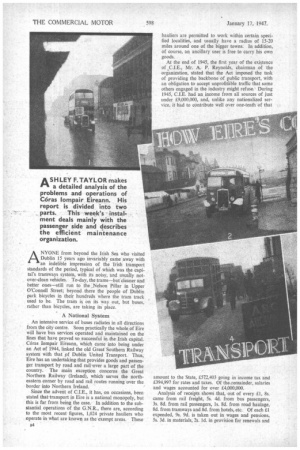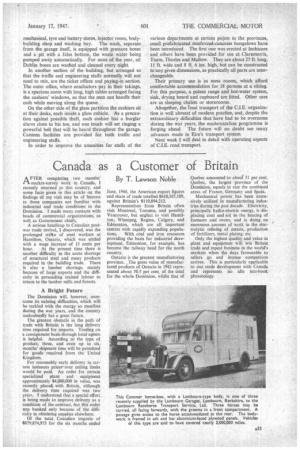A SH LEY F. TAYLOR makes a detailed analysis of
Page 38

Page 39

Page 40

Page 43

If you've noticed an error in this article please click here to report it so we can fix it.
the problems and operations of C6ras lompair Eireann. His report is divided into two parts. This week's instalment deals mainly with the passenger side and describes the efficient maintenance organization.
ANYONE from beyond the Irish Sea who visited Dublin 15 years ago invariably came away with an indelible impression of the Irish transport standards of the period, typical of which was the capital's tramways system, with its noisy, and usually notover-clean vehicles. To-day, the trams—but-cleaner and better ones—still run to the Nelson Pillar in Upper O'Connell Street; beyond there the people of Dublin park bicycles in their hundreds where the tram track used to be. The tram is on its way out, but buses, rather than bicycles, are taking its place.
A National System An intensive service of buses radiates in all directions from the city centre. Soon practically the whole of Eire will have bus services operated and maintained on the lines that have proved so successful in the Irish capital. COras Iompair Eireann, which came into being under an Act of 1944, linked the old Great Southern Railway system with that of Dublin United Transport. Thus, Eire has an undertaking that provides goods and passenger transport by road and rail over a large part of the country. The main exception concerns the Great Northern Railway (Ireland), which serves the northeastern corner by road and rail routes running over the border into Northern Ireland.
Since the advent of C.I.E., it has, on occasions, been stated that transport in Eire is a national monopoly, but this is far from being the case. In addition to the substantial operations of the G.N.R., there are, according to the most recent figures, 1,024 private hauliers who operate in what are known as the exempt areas. These hauliers are permitted to work within certain specified localities, and usually have a radius of 15-20 miles around one of the bigger towns. In addition, of course, an ancillary user is free to carry his own goods.
At the end of 1945, the first year of the existence of ,C.I.E., Mr. A. P. Reynolds, chairman of the organization, stated that the Act imposed the task of providing the backbone of public transport, with an obligation to accept unprofitable traffic that some others engaged in the industry might refuse. During 1945, CIE. had an income from all sources of just under £9,000,000, and, unlike any nationalized service, it had to contribute well over one-tenth of that amount to the State, £572,403 going in income tax and £394,997 for rates and taxes. Of the-remainder, salaries and wages accounted for over £4,000,000.
Analysis of receipts shows that, out of every £1, 8s. came from rail freight, 5s. 4d. from bus passengers, 3s. 8d, from rail passengers, Is. 8d. from road haulage, 8d. from tramways and 8d. from hotels, etc. Of each £1 expended, 9s. 9d. is taken out in wages and pensions, 5s. 3d. in materials, 2s. Id. in provision for renewals and depreciation, Is. 8d. in rates and taxes, 8d. in interest and dividends, and 7d. for miscellaneous charges.
It is against this financial background that the future transport of Eire is being planned. The vision of the future is of fast, long-distance trains, with road transport providing for both freight and passenger needs up to a distance of 40 or 50 miles. For the moment, however, Eire's transport is busy putting its house in the best possible order. Many new vehicles are being put on the road, maintenance systems that have been successful in Dublin are being extended throughout the provinces, and much is being done to improve travelling.
Perhaps the most important step taken during the past year was the widespread reduction of fares. Whilst undertakings in Britain were making application for fares increases, Eire made a cut equivalent to 1750,000 for a full year's working. This reduction took effect from July 1 and, particularly in the case of city families, represented a most useful lowering of the cost of living for the man in the street. Fares in Cork city, which in former days were on the high -side, have in some cases been halved, whilst in Dublin all odd halfpenny fares have been reduced to level amounts. Travel within Dublin city centre usually costs Id., and it is possible to make a journey of six or seven miles from one side of the city to the other for 3d. Rationalized fares have been introduced on all long-distance routes to the capital, but, generally speaking, the reductions have applied only to journeys costing not more than 7s. 6d. On the country services the average charge at present is approximately 1.3d. per mile.
The war has spelt great difficulties for transport executives in Eire. Expansion and renewal programmes had to be completely cancelled, and in order to carry the people it was necessary to institute hand-to-mouth maintenance and operational systems probabbafar more difficult than those encountered anywhere dse in these islands.
Buses Prove Their Worth
First of all, the replacement of the Dublin trams would, but for the war, have been completed in 1941; at the outbreak of war there were already 85 double-decker chassis on order from Leyland Motors, Ltd. Among a certain section of Dublin people there had been some opposition to the proposed abandonment of the tramways system, but the value of the buses was amply proved during the war, especially in 1944, when, for a period, sheer lack of electricity caused a complete suspension of tramways operations.
In order to keep the buses running, however, cannibalization on a large scale had to be undertaken, and there were remarkable efforts by the engineering department in the fabrication of sorely needed components. Shortages are still a major problem, although purchases
are being made not only in Great Britain, but in the United States, Canada, Belgium, Switzerland and South America.
Among the important projects now in hand is the Dublin bus station for long-distance services. The site is adjacent to Store Street, near the Custom House, and a modern design has been evolved after a careful study of Continental and Transatlantic designs. Not only will it provide platform accommodation for 24 vehicles, a restaurant, a news theatre and many other amenities for bus passengers, but it will also include an extensive administrative block, which will house most of the C.I.E. executive and headquarters staff.
In order to effect further improvements in the bus services, representations have been made for the raising of the legal speed limit for double7deck buses operating in Eire from 20 m.p.h. to 30 m.p.h. Although this increased maximum is not likely to affect the city services, with their many stops, on the mediumdistance runs from the capital it should be a distinct advantage. For single-deckers the• speed limit in Eire is already 35 m.p.h., and no increase in this figure has been sought, but it is hoped to improve the service times by reducing the length of intermediate stops.
In connection with the provincial services there is an important demand for greater cornfort for the waiting passengers; as some 1,100 towns and villages are served, the problem of how to satisfy this desire is no simple one. It seems that there is no readily available alternative to the system of shopkeepers or cafe pro prietors acting as agents, and, as such, providing accommodation and information for passengers, also carrying out collections and deliveries of parcels for transport by bus.
Probably the most notable of recent developments in the C.I.E. organization is the creation of a new type of bus depot, which is to be constructed at strategic points throughout the country. Donnybrook Garage, which is the prototype, has accommodation for 100 vehicles and is laid out with the administration offices and stores at the rear, and the traffic inspectors' offices at the main entrance.
The garage superintendent's and foreman's offices are situated on the first floor, with windows arranged so that it is possible to survey the entire floor without difficulty. Immediately in front of the offices are the repair and inspection pits, with work benches on the same ffoor level. The benches arc placed against the windows and have excellent natural lighting, whilst the pits themselves are white tiled and illuminated by panel lights. Recessed in the wall of each pit is a sump-draining tray, which
swings out beneath the drain hole, and waste oil passes by means of a pipe line to a main reclamation tank beneath the garage floor.
Among other fittings of the pits are pressure lines which supply gear oil, spring oil and high-pressure grease. A fume extractor plant is used to minimize air pollution.
Beneath the administrative section is located a bay fitted with Stream-Line filters for the purpose of oil recovery. Over 90 per cent. of the oil from the reclamation tank is available for fresh use after cleansing.
Other features of the garage are a first-aid room, mechanical, tyre and battery stores, injector room, bodybuilding shop and washing bay. The wash, separate from the garage itself, is equipped with pressure hoses and a pit with a false bottom, the waste water being pumped away automatically. For most of the year, all Dublin buses are washed and cleaned every night.
In another section of the building, but arranged so that the traffic and engineering staffs normally will not need to mix, are the ticket offices and paying-in section. The outer office, where conductors pay in their takings, is a spacious room with long, high tables arranged facing the cashiers' windows, so that the men can handle their cash while moving along the queue.
On the other side of the glass partition the cashiers sit at their desks, each inside a glass cubicle. As a precaution against possible theft, each cashier has a burglar alarm close to his toe, and one touch will set ringing a powerful bell that will be heard throughout the garage. Canteen facilities are provided for both traffic and engineering staffs.
In order to improve the amenities for staffs of the various departments at certain points in the provinces, small prefabricated reinforced-concrete bungalows have been introduced. The first one was erected at Inchicore and others have been provided for use at Claremorris, Tuam, Thurles and Mallow. They are about 25 ft. long, 11 ft. wide and 8 ft. 6 ins, high, but can be constructed to any given dimensions, as practically all parts are interchangeable.
Their primary use is as mess rooms, which afford comfortable accommodation for 18 persons at a sitting. For this purpose, a patent range and hot-water system, sink, drying board and cupboard are fitted. Other uses are as sleeping chalets or storerooms.
Altogether, the load transport of the CIE. organization is well abreast of modern practice, and, despite the extraordinary difficulties that have had to be overcome during the war years, the modernization programme is forging ahead The future will no doubt sec many advances made in Eire's transport system.
Next week I will deal in detail with operating aspects of C.I.E. road transport.












































































